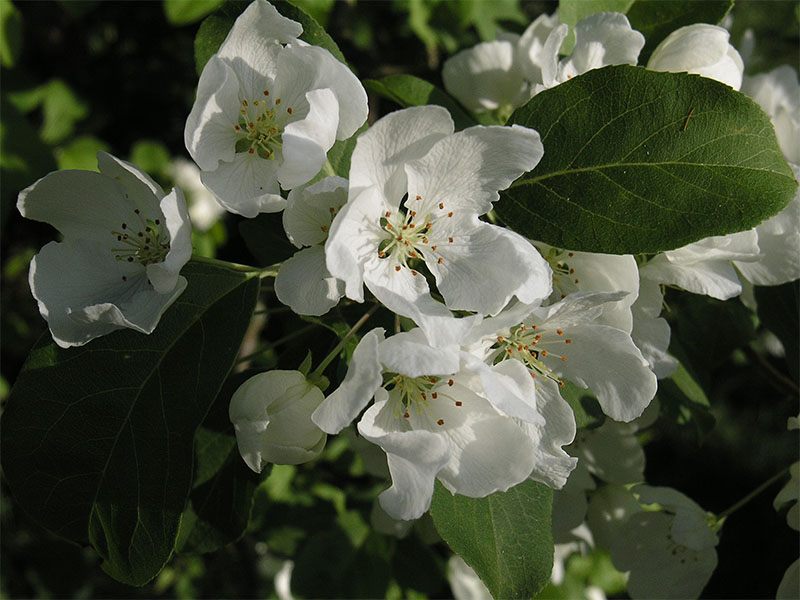
Woody > Malus > Malus baccata > Malus baccata
Malus baccata
Siberian Crabapple, Flowering Crabapple
Origin: Siberia, northern temperate areas of Asia, North America and Europe.
Mike's
Opinion


"
A species of which many cultivars originate from today. Malus baccata is an excellent, though perhaps underused tree. With its stocky form and abundance of small, attractive flowers, I am surprised that it is not more commonly used as a street tree. Said to be slightly messy upon fruit and flower drop, clean-up seems to be a small task to undertake given the many positive attributes this tree has to offer.
Michael Pascoe, NDP., ODH., CLT., MSc. (Plant Conservation)
"
| Family |
| Rosaceae |
| Genus |
| Malus |
| Species |
| baccata |
| Category |
| Woody |
| Type |
| Tree (deciduous) |
| Pronunciation |
| USDA Hardiness Zone |
| 2-9 |
| Canadian Hardiness Zone |
| 3-10 |
| Temperature (°C) |
| -44 |
| Temperature (°F) |
| -47 |
| Height |
| 7-12 m |
| Spread |
| 12 m |
Photographs
Description and Growing Information
Flowering Period
| General Description |
| A tree of medium to moderate growth rate that is often found with branches beginning low on the trunk, which lead up to and create the full, circular crown. Very effective when used for shade or ornamental purposes. |
| Landscape |
| Used for aesthetic and decorative characteristics, especially during the winter months where condensed branching and bright fruit provide interest and food for birds. In the spring, sweet-scented flowers are also attractive to passing pollinators. While the fruit is not palatable when consumed raw, they can be incorporated into various recipes. May also serve well as a shade tree. |
| Cultivation |
| For optimal production of flowers and fruit, full sun is required, along with a moist soil that allows for drainage. A soil pH of 5.0-6.5 is ideal, though found to be quite compliant with a range of soil types. Will tolerate a harsh winter. |
| Shape |
| A circular crown that is quite sturdy, with outspread branches that seldom need pruning. |
| Growth |
| Medium |
| ID Characteristic |
| This tree has many prominent white flowers in the spring, and colourful fruit that carry on through the winter months. |
| Pests |
| Can suffer from apple scab, powdery mildew, and fireblight, as well as aphids. |
| Habitat |
| Can be found in meadows or groves in the northern temperate areas of Asia, North America and Europe. |
| Bark/Stem Description |
| The trunk is rough and brown, can display reddish hues, branches can be grey. |
| Flower/Leaf Bud Description |
| Pinkish in colour, forms singular 3-6 mm buds that bloom in the spring. |
| Leaf Description |
| Deciduous green leaves that are pointed at the tips, serrated, and occasionally covered in fine hairs along the centre vein. Approximately 2-8 cm long and 1-6 cm wide. |
| Flower Description |
| Approximately 2.5-3.5 cm in diameter, usually white but sometimes cream coloured, fragrant, and quickly shed. |
| Fruit Description |
| Small and circular, 1 cm in diameter, ranging from yellow to red to orange, sometimes having a mixture of said colours. Lasting throughout the winter, the fruit will attract birds and squirrels. |
| Colour Description |
| The leaves of this tree are green, with a slightly lighter shade of green on the undersides. In autumn the leaves turn yellow, but fail to leave any spectacular impression. |
| Texture Description |
| Leaves and petioles range from smooth to pubescent, usually becoming rid of the fine hairs with maturity. |
| Notable Specimens |
| Royal Botanical Gardens, Burlington, Ontario, Canada. |
| Propagation |
| Budding is to be done in the summer months, grafting in the winter. Root, seed and softwood cuttings are common, as well as tissue culture. A 2-3 month stratification period at 3-5°C is required before germination. |
References
Glen Echo Nurseries Inc., Caledon, Ontario.
Though many other nurseries will carry the fastigiate cultivar of
this specimen, it can sometimes be found growing wild.

